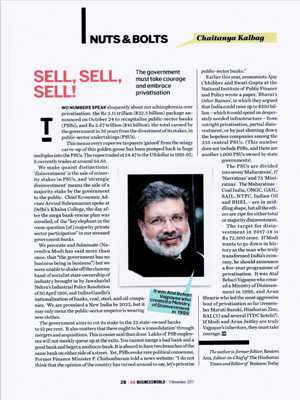SELL SELL SELL
[Business World]
Published date: 11 Nov 2017
Two numbers speak eloquently about our schizophrenia over privatisation: the Rs 2.11trillion ($32.5 billion) package announced on October 24 to recapitalise public-sector banks (PSBs); and Rs 2.67 trillion ($41 billion), the total earned by the government in 26 years from the divestment of its stakes, in public-sector undertakings (PSUs).
This means every rupee we taxpayers ‘gained’ from the mingy carve-up of this golden goose has been pumped back in huge multiples into the PSUs.The rupee traded at 24.47to the US dollar in1991-92; it currently trades at around 64.85.
We make quaint distinction : ‘disinvestment’ is the sale of minority stakes in PSUs, and ‘strategic disinvestment’ means the sale of a majority stake by the government to the public. Chief Economic Adviser Arvind Subramanian spoke at Delhi’s Khalsa College, the day after the mega bank-rescue plan was unveiled, of the “key elephant in the room question [of] majority private sector participation “in our stressed government banks.
We perorate and fulminate (Narendra Modi has said more than once, that “the government has no business being in business”) but we seem unable to shake off the clammy hand of socialist state ownership of industry brought in by Jawaharlal Nehru’s Industrial Policy Resolution of30April 1956, and Indira Gandhi’s nationalisation of banks, coal, steel, and oil companies. We are promised a New India by 2022, but it may only mean the public-sector emperor is wearing new clothes.
The government aims to cut its stake in the 22 state-owned bank to 52 per cent. It also mutters that there ought to be a’ consolidation’ through mergers and acquisitions. This is easier said than done. Lakhs of PSB employees will not meekly queue up at the exits. You cannot merge a bad bank and a good bank and beget a mediocre bank. It is absurd to have two branches of the same bank on either side of a street. Yet, PSBs evoke rare political consensus. Former Finance Minister P. Chidambaram told a news website: “I do not think that the opinion of the country has turned around to say,let’s privatise public-sector banks.”
Earlier this year, economists Ajay Chhibber and Swati Gupta at the National Institute of Public Finance and Policy wrote a paper, ‘Bharat’s Other Ratnas’, in which they argued that lndia could raise upto $250 billion -which it could spend on desperately needed infrastructure – from outright privatisation, partial disinvestment, or by just shutting down the hopeless companies among the 235 central PSUs. (This number does not include PSBs, and there are another 1,000 PSUs owned by state governments).
The PSUs are divided into seven ‘Maharatnas’,17 ‘Navratnas’ and 73 ‘Miniratnas’. The Maharatnas- Coal India, ONGC, GAIL, SAIL, NTPC, Indian Oil and BHEL – are in middling shape, but all the others are ripe for either total or majority disinvestment. The target for disinvestment in 2017-18 is Rs 72,500 crore. If Modi wants to go down in his tory as the man who truly transformed India’s economy, he should announce a five-year programme of privatisation. It was Atal Behari Vajpayee who created a Ministry of Disinvestment in 1999, and Arun Shourie who led the most aggressive bout of privatisation so far (remember Maruti Suzuki, Hindustan Zinc, BALCO and several !TDC hotels?). If Modi and Arun Jaitley are truly Vajpayee’sinheritors, they must take courage.






